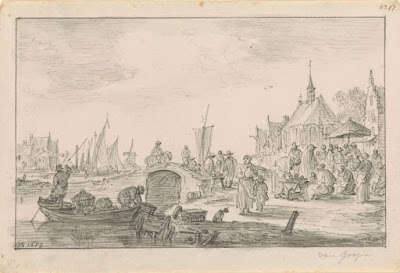Jan van Goyen
(1596-1656)
"Gesicht op Alphen by Leyden"
 |
| Market in a Duch village near a river. |
Some details showing the markings left by the instruments ("Roulettes") to simulate pencil drawing:
Although it looks every bit a pencil drawing this: "View on Alphen near Leyden", however is not a drawing but an engraved copy I found recently in a charity shop. It was created by Irish engraver William Baillie (1723-1810) who besides his military career was an eminent amateur artist. Baillie was hired by the Duke of Bute, John Stuart (1713-1792), Prime Minisister of Great Britain 1762/63 to create engraved copies of works in his art collection.
 |
| Jan van Goyen: view on Leyden |
Baillie is also known to have owned several original Rembrandt (1606-1669) etching plates. He reworked the worn out plates and, not to every ones taste altered Rembrandt's composition of the "three trees on a hill" print by adding clouds and lightning. He'd better not.
Three trees: Rembrandt and Baillie
Hansken: Rembrandt and Baillie
Baillies copy of Stuarts drawing by Pieter Molyn (1595-1668)
Invented in Britain, in the late 17the century, "Mezzotint" engraving grew into a craze during the 18th century used to copy entire collections of Old Masters paintings, portraits etc.. It was also called the "Black Art", starting with a black plate, rubbing in the lighter parts with instruments called "Roulettes".
The duke of Devonshire hired Baillie's colleague engraver Richard Earlom (1743-1822) to copy his art collection including his many paintings by Claude Loraine (1602-1682) (below). Loraine was William Turners' (1775-1851) inspiration, read here*).
Studying drawings by van Goyen I noticed he was intrigued by the artistic possibilities of depicting the mechanical tackling device called in Dutch a "Putmik" or "Puthaal" (English .....?) used for hauling water buckets or freight. The strong diagonals of the contraption breaking the horizontal and vertical landscape composition attracting strongly the eye and leading through the composition. He used it often: when shipsails or yards were not available.
Here are some examples of this device that was in use in rural areas into the 20th century.
















No comments:
Post a Comment